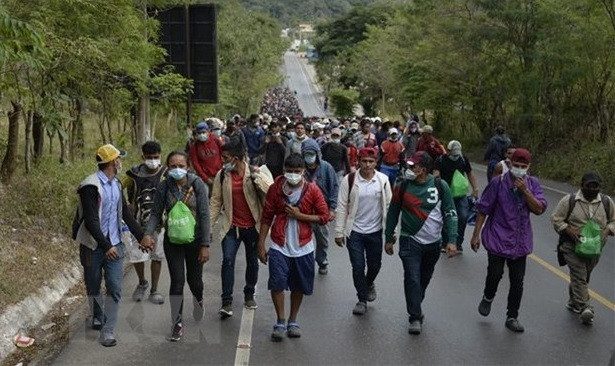Despite the risks of illness, kidnapping, and even murder, about 500,000 people from Central American countries choose to embark on a thorny journey every year, hoping to reach their “American dream”. Behind those dreams is a cruel reality. The United Nations Children's Fund (UNICEF) announced that of the 19,000 children who migrated across the border between Colombia and Panama by crossing the Darien rainforest in 2021, at least 5 children died, and nearly 30 children were abused.
The lack of food, medicine and shelter in the midst of extreme weather makes the fate of migrants more fragile than ever. Even so, illegal migration in Central America continues to spread. Right now, many people from Central America are stranded at Mexico's southern border, bordering Guatemala, and at the Mexico-U.S. border.
Poverty, violence and natural disasters are the reasons why people in Haiti, Guatemala, Honduras, El Salvador, etc.,are seeking to enter the US. The emergence of the COVID-19 pandemic has exacerbated the migration problem. According to the United Nations, the poverty rate in Latin American countries has reached 9.1%, the highest level in 15 years. The pandemic has dealt a heavy blow to the job market, pushing people into misery.
In the period of 2019-2020 alone, the number of people without enough food in Latin America increased from 13.8 million to 59.7 million. Even before the arrival of the COVID-19 epidemic, food insecurity was a “serious disease” of this region. According to a survey conducted in Guatemala, Honduras and El Salvador, up to 92% of respondents said that economic hardship was the main motivation for them to leave their homelands.
For nearly a year as the head of the US, President Joe Biden has made efforts to deploy investment packages and support for socio-economic development to create a “wall of prosperity” in Central America, the origin of the migration wave. The programme recently announced by the US and Mexico is part of a series of efforts promoted by the US to stem the flow of migration at the root.
The programme, which was first launched in Honduras, aims to support Central American youth through vocational scholarships, funding for agricultural development projects, and youth workforce development. Previously, the US and Mexico also signed a memorandum of understanding on promoting social welfare in Central America, scaling up programmes such as afforestation, granting scholarships to students, etc.
As soon as he came to power, President Joe Biden signed a series of decrees reversing the previous administration's tough immigration policies, offering a more humane approach. But many people think that this policy may encourage more people to illegally cross the border into the US.
In fact, in recent months, the number of Central American migrants coming to the US border has increased rapidly, creating pressure on the White House. In a recent survey, 57% of Americans said that Joe Biden is not tough enough on immigration.
Facing mixed opinions, President Joe Biden acknowledged that it is not easy to solve such a long-lasting problem for the US, but he also affirmed that migrant children cannot be left to starve and trapped on the other side of the border.
Migrants are still flocking to the “promised land” in the hope of improving their lives. The fact that the US is cooperating with other countries to find ways to solve the root cause of the difficult migration problem, aiming to eliminate poverty and violence in Central America, is a necessary and appropriate step.
These actions affirm Washington’s determination to approach migration in a comprehensive and sustainable manner, even though such radical solutions take time and persistent efforts to show results.
















